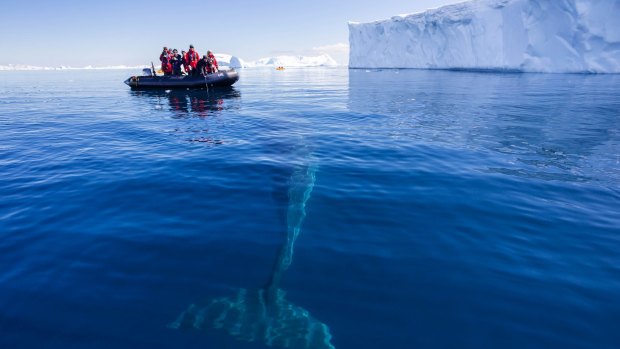By Jim Darby

A young minke whale investigates a group of whale watchers exploring Curtis Bay within the Antarctic Peninsula. Credit: Boomer Jerritt
The PA in the cabin crackles to life: "This is earlier than the early call you were expecting," says Dick Filby, wildlife expert and enthusiast in his deep, clear, BBC-style voice. "But folks, there are about six orcas, six killer whales, off the bow."
I throw on a few layers and some boots and a beanie and there they are, half a dozen of them in living black and white. Diving, surfacing and blowing in unison, they slide through the water with skin as smooth as kelp and dorsal fins like scythes.
It's mid-November in Antarctica and this is early for whales. Many of them are still making their way south, but still we pass some submarine-sized southern blue whales and a pod of fin whales in the Drake Passage. On scene in Antarctica, we add humpback and sei whales and the orcas to the list.
I'm aboard a One Ocean cruise on the hardy ship, the Akademik Ioffe, and the expedition staff make up a university of Antarctica: biologists, ornithologists, Antarctic historians and experts in its politics and practicalities, as well as a couple of artists and a top wildlife photographer (Daisy Gilardini).
They share an obsession with the White Continent, and they share a talent for storytelling, something that fills the hours on the cruise down and back. Reaching wider than their commercial remit, One Ocean also host a couple of scientists from California using drones to better understand whale behaviour.
Towards the end of our time in Antarctica, unable to make shore one morning, we take a "Zodiac safari". The weather is calm and cool with soft flurries of snow falling from a grey sky and a thin mist drifting over water that holds hardly a ripple.
The wildlife is all around – a Weddell seal sleeping it off on an iceberg and gentoo, Adelie and chinstrap penguins shooting through the water in their little squads (penguins carry perfect collective nouns – in the water they are a raft, on land a waddle).
Another group radio a humpback whale sighting but we are so involved with iceberg-watching, we stay where we are. Some of the ice is so clear, it might as well have come from the fridge, clinking along in the water looking for its gin and tonic.
Some of the bigger bergs are blindingly white on top, moving through every blue on the spectrum, the deepest of it disappearing with them into the ocean. Some icebergs look like flying wedges, others have patterns like organ pipes or big windows cracked open in them. Some have enough peaks to make a mini-mountain range.
Franco Mariotti, a One Ocean biologist is in our Zodiac and is a font of fast facts: "You know, a snowflake that falls on the continent of Antarctica might take 100,000 years to reach the coast and the sea." This place is all about patience and survival.
For most of the expedition, we are piloted by cape petrels. They slipstream the ship and dart along the swell lines, almost touching their wings to the water as they turn, as though throwing their favourite wind-surfing manoeuvre.
Heading home over the Drake Passage, Dick Filby is back on the blower: "Excuse the interruption folks, but we've just seen five different types of albatross, the rear deck is the place to be. It's a bit cold and a bit slippery so rug up and come on down, this is the greatest show on earth."
There they are, southern royal and wandering albatross among them, birds with massive, three-metre-plus wingspans, sailing on the wind. I watch one for 20 minutes and not once does it flap those wings. They spend most of their life in flight and at sea, landing only to breed and to feed. They mate for life, these masters of the sea, and breed every second year, nesting on the isolated islands of the Southern Ocean.
We sail past Cape Horn, it is too rough to land, but I'm not surprised to learn of a memorial near the Cape, a sculpture of an albatross in flight known as the "Albatross at the end of the world".
It is a tribute to the thousands of sailors that perished in these waters and it carries some verse by Chilean poet Sara Vial, including these lines:
"But they did not perish/In the furious waves./Today they fly on my wings for all eternity/in the ultimate embrace/of the Antarctic winds."
TRIP NOTES
MORE
CRUISE
One Ocean's "Antarctica – Off The Beaten Track", 12-night expedition has two departures in November 2018 and offers skiing, sea kayaking, snow-shoeing and overnight camping. Twin share starts at $US8495 per person, not including flights and some activities. See oneoceanexpeditions.com and antarcticatravelcentre.com.au
FLY
LATAM flies direct from Melbourne and Sydney to Santiago, with connections through to Ushuaia for Antarctic cruises; see latam.com
Jim Darby travelled as a guest of LATAM, One Ocean Expeditions and the Antarctica Travel Centre
Sign up for the Traveller Deals newsletter
Get exclusive travel deals delivered straight to your inbox. Sign up now.